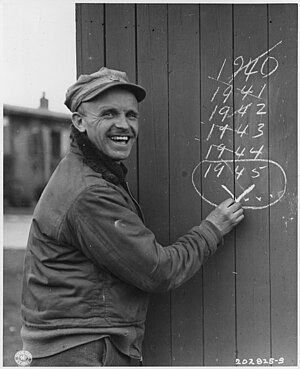Dulag Luft
| Dulag Luft | |
|---|---|
| Oberursel, Hesse | |

Sgt. Edward Hill of Manchester, England, freed from five years of captivity at Dulag Luft, by the American Seventh Armored Division, First Army, c.29 March 1945
|
|
| Coordinates | 50°13′00″N 8°33′13″E / 50.21654°N 8.55366°E |
| Type | Prisoner-of-war camp |
| Site information | |
| Controlled by |
|
| Site history | |
| In use | 1939 – 1945 |
| Garrison information | |
| Occupants | Allied aircrew |
Dulag Luft was the abbreviated name given to Prisoner of War (POW) transit camps for Air Force prisoners captured by Germany during the Second World War. Their main purpose was to act as collection and interrogation centres for newly captured aircrew, before being transferred in batches to the permanent camps. Dulag Luft derives from the German Durchgangslager der Luftwaffe (Transit Camp - Air Force).
Several camps were set up throughout Germany and the occupied countries, however the main centre used throughout the war was at Oberursel near Frankfurt. A satellite camp at Wetzlar was set up later in the war to help cope with the large numbers of aircrew captured as the bombing campaign intensified against Germany. Allegations of interrogation under torture have been made by numerous POWs who passed through the camps.
The Germans had established a similar facility, the "Listening Hotel", in the First World War. This was located at 39 Ettlinger Strasse in Karlsruhe and was a former business hotel, the Europäischer Hof. The "Listening Hotel" should not be confused with the regular Officers' Camp in Karlsuhe in that war.
The camp was built on the site of an old government poultry farm, approximately 300 yards north of the main Frankfurt to Bad Homburg road. The camp first opened in December 1939 when a small number of British and French POWs were transferred in from Oflag IX-A/H. These first prisoners were to act as a permanent staff of the camp to help new POWs become accustomed to camp life. The main building, known as the stonehouse, had been used as a prison for a small number of airmen captured in the early months of the war, before it became a transit camp.
The stonehouse, which had been used to house farm pupils prior to its conversion to the prison camp, was originally the only building in the camp, however from April 1940 onwards the camp expanded with the completion of three wooden barrack blocks. After this point the stonehouse was used as the interrogation centre for new POWs, and the barrack blocks were used to house the permanent staff POWs and other POWs awaiting transfer to other camps. The first Senior British Officer (SBO) was Wing Commander Harry Day. The camp steadily grew in size.
...
Wikipedia

